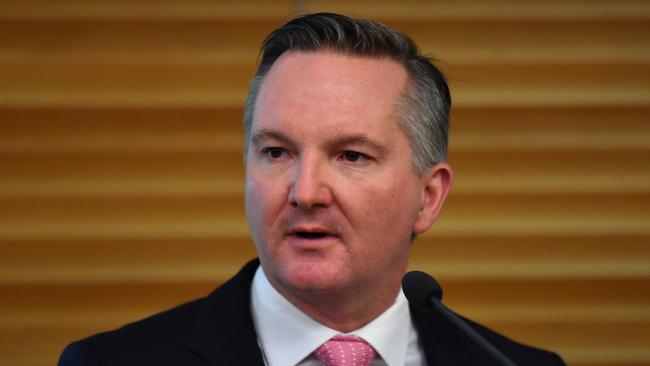Chris Bowen caught out on negative gearing numbers
Josh Frydenberg has accused Labor of “lying” about inaccurate figures behind its negative gearing reforms.

Josh Frydenberg has accused Labor of “lying” about inaccurate figures behind its negative gearing reforms, and warns there could be “a big black hole” in their election costings as a result.
The Australian Bureau of Statistics has denied claims it had produced data showing that only 7 per cent of property investors bought new homes, despite opposition treasury spokesman Chris Bowen using those figures repeatedly to back his housing policy.
The Treasurer said Mr Bowen had been “caught out” over the ABS revelations and had to “come clean” about Labor’s sums in his budget reply speech later today.
“Bill Shorten and Chris Bowen have been tripping over their shoe laces and the election hasn’t even begun,” the Treasurer told Sydney’s 2GB radio this morning.
“The Labor Party in reality may see a big black hole in them because they have underestimated the number of negative gearers who use new homes.
“Clearly they are (lying) and clearly there is a black hole in their costings ... they have overstated the amount of savings they will get from this policy, and this is a $35bn slug on the taxpayer.
“Chris Bowen needs to come clean about the data.”
Mr Bowen’s use of ABS data has also been challenged by the Grattan Institute, a public policy think tank, which has argued that 14 per cent of investors buy new properties rather than existing ones — an estimate that is double what Labor has claimed.
Mr Bowen, Labor’s chief economic salesman, has repeatedly referred to ABS figures purportedly showing that negative gearing has failed to promote construction in new housing and create jobs.
“The most recent Australian Bureau of Statistics data shows that 93 per cent of new investment loans go to people purchasing existing housing stock,” he said as recently as January.
“This means that the vast bulk of investment does not increase supply or boost jobs.
“All it does is increase demand and the price of the existing homes, allowing investors to use tax subsidies to outbid owner-occupiers and first-home buyers.”
Mr Bowen took to Twitter today to defend his negative gearing costings and said the PBO had re-affirmed his numbers. “You are just plain wrong I am afraid Josh (Frydenberg). Independent Parliamentary Budget Office costs Labor’s policies including negative gearing and they have re-affirmed they stand by their costing. Nice try,” he tweeted this morning.
You are just plain wrong I am afraid Josh. Independent Parliamentary Budget Office costs Labor’s policies including negative gearing and they have re-affirmed they stand by their costing. Nice try.
— Chris Bowen (@Bowenchris) April 9, 2019
But ABS financial statistics analyst Tony Mitchell said the agency did not collate the figures Mr Bowen had been referring to since 2016.
“If you wanted to have those numbers you wouldn’t be able to get them from our statistics because we don’t collect them,” Mr Mitchell told The Australian.
“We’ve got a little bit about construction, but it is to do with lending to businesses for construction of investment dwellings. It is not to do with lending to households for construction of investment dwellings.
“There is nothing about lending for newly constructed dwellings. That is included in other statistics, but you can’t break it out.”
Mr Bowen was forced to clarify his costings with the Parliamentary Budget Office after the property industry claimed his numbers were wrong and that could impact on the claimed savings from Labor’s policy.
The PBO has estimated that Labor’s policies to reform negative gearing and the capital gains tax discount will raise $2.9 billion over the forward estimates and $35.1bn over the decade.
“The PBO stands by the costing,” Mr Bowen said. “The PBO consulted with the ABS, the RBA and major banks in order to estimate the proportion of investor lending for the purpose of existing housing.
“The PBO costing has relied on ABS data on owner-occupier lending with other data sources, including unpublished data by the RBA regarding lending to households for residential property investment, and other surveys of investor lending.”
Housing Industry of Australia principal economist Tim Reardon said anecdotal evidence suggested that the number of investors who bought new properties was at least 30 per cent.
“We know intuitively that 7 per cent number that Bowen is quoting is wrong,” Mr Reardon said.
“Last year there were 70,000 apartments sold in Australia and we know from talking to developers that at least half of those went to investors, possibly as high as 60 per cent.”
Grattan Institute director Danielle Wood said the independent think tank had estimated that more investors bought new properties than Labor was claiming.
“It is right that you can’t directly calculate it from the ABS data because some of the finance is going into homes that are newly constructed and you can’t see the split between investors and owner-occupiers for that category,” Ms Wood said.
She said there would be a budget impact if the PBO based its assumptions on the figures Labor was claiming, as more investors would be eligible to receive the tax subsidy.
“It would have an impact on the costing but I can’t imagine that it is going to be very large in the scheme of things,” Ms Wood said.




To join the conversation, please log in. Don't have an account? Register
Join the conversation, you are commenting as Logout